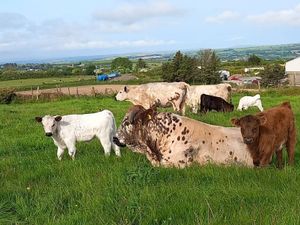Ancient Cattle of Wales added to watchlist for urgent action to save rare breeds
The breed has been added to the Rare Breeds Survival Trust’s watchlist for priority action to conserve the animals.

Rare Welsh cattle with a heritage stretching back more than 1,000 years have been added to a watchlist of native livestock breeds at risk of dying out.
The Ancient Cattle of Wales breed has been added to the Rare Breeds Survival Trust’s (RBST) priority category in its latest watchlist, meaning it is in the most urgent need of action to ensure its survival.
The RBST said the hardy farm animals have valuable traits, such as being an economical beef breed which produces well-flavoured meat and does well on the less-favoured grassland in the uplands.
The breed is also “excellent” for conservation grazing, which can help nature.
But it is now in a “grave situation” with a concerning decline in the number of new calves being registered and several established herds being disbanded as their owners retired, the organisation said.

The breed has an ancient pedigree, with evidence of the presence of coloured cattle in Wales dating back to the time of Welsh king Hywel Dda in the 10th century, the RBST said.
The medium-sized cattle, with large ears and soft, thick hair, have six colour variations including white with black or red points, belted, red, blue, smokey or mouse coloured and “line back” – any colour with a white line along its back, tail and underside.
Particular colours tended to be more popular in certain areas, but numbers declined until the Ancient Cattle of Wales were only kept and bred in a few remote hill farms in Wales.
A group of farmers identified the remaining coloured cattle in the Welsh uplands in the 1970s, and since it was formed in 1981, the Ancient Cattle of Wales Society (Gwartheg Hynafol Cymru) has detailed the breed, created a herd book for pedigree cattle and worked on increasing its population.
The RBST said listing the Ancient Cattle of Wales on its watchlist would bring new support for conserving and promoting the breed.
The trust’s chief executive Christopher Price said: “The Ancient Cattle of Wales is a valuable breed for today’s farming needs, as well as for its irreplaceable heritage value.
“The breed is excellent for conservation grazing that supports the environment and biodiversity, and it is a good economical beef breed in hill and upland situations.

“However there has been a really concerning decline in new birth registrations over the last few years, as well as several well-established herds being disbanded following retirement of their owners.
“The breed is in a grave situation right now, but RBST is looking forward to working with the Ancient Cattle of Wales Society to secure a more stable situation.”
He added: “Ultimately, we want to see the breed thriving again: these hardy cattle can make a key contribution in the UK’s future farming, where food production goes hand in hand with the environment.”
Mike Lewis, chairman of the Ancient Cattle of Wales Society (Gwartheg Hynafol Cymru), said: “With registered cattle numbers in the low hundreds, I and the wider ACW Society look forward to working with RBST to continue to promote and protect this very special Welsh breed.”





